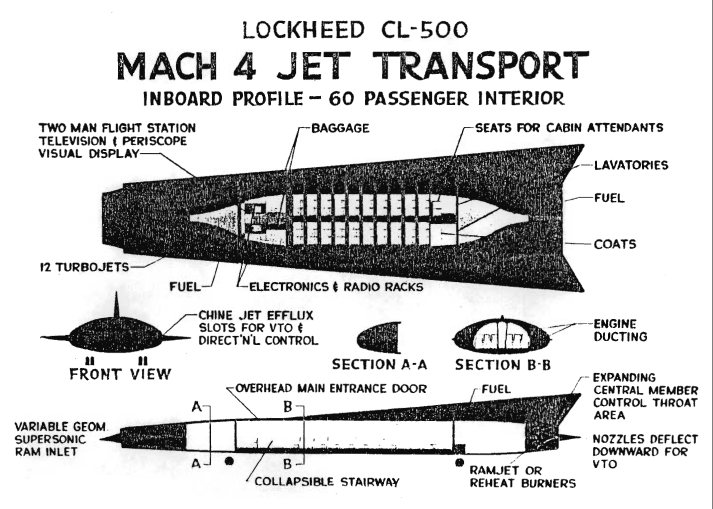Jan 042009
If you’re gonna dream, dream wacky. The Lockheed CL-500 featured vertical takeoff and landing with no wings… and no windows. And if some of the engines crap out, no way of landing. There’d be no gliding it in, or landing conventionally on a runway…. this thing would have the glideslope of a old shoe filled with lead shot and wet cement.
Other variants of this idea were supposed to aim for Mach 7.
5 Responses to “Lockheed CL-500: VTOL SST”
Sorry, the comment form is closed at this time.

What year is that supposed to date from?
Actually, it might be able to glide, as it’s a lifting body in design, although landing speed in a conventional mode would be very high due to its sink rate.
How come I get the feeling that this is a civilian offshoot of a design concept that originally had bombs, not passengers, in it?
Also, why do you get into it from the top – not bottom or side – of the fuselage?
> why do you get into it from the top
Look at “Section B-B” and see if’n that doesn’t answer your question…
No. it really doesn’t.
It shows some sort of thick insulation flooring under the crew/passenger compartment, but doesn’t explain why that can’t be pierced with some sort of belly hatch.
Here’s a good one for you – what’s the difference between a Lockheed “L” design designation and a “CL” one?
I was digging through my “Skunk Works” book by Jay Miller, and the only thing I could come up with as a theory was that “CL” meant “Classified Lockheed” and the simple “L” meant “Lockheed”.
Landing gear’s too short to allow people to walk underneath. It’d be easier to build all-new jetbridges at airports that permit overhead access than to build armored underground tunnels. It would also be easier to build overhead jetbridges which can move to adjust to the position of the parked aircraft than build movable underground tunnels.
> what’s the difference between a Lockheed “L” design designation and a “CL” one?
L = Lockheed
CL = California Lockheed
GL = Georgia Lockheed
From what I understand about Hypersonic design, penatrations through the TOP are easier to insulate and control heat flow as during cruise any ‘positive’ angle of attach has the upper shock-wave helping keep heating lower than on the bottom where the shock is usually captured to increase lift.
Most likely though it because the “original” bombs also exited the top :o)
Thanks Scott
Randy